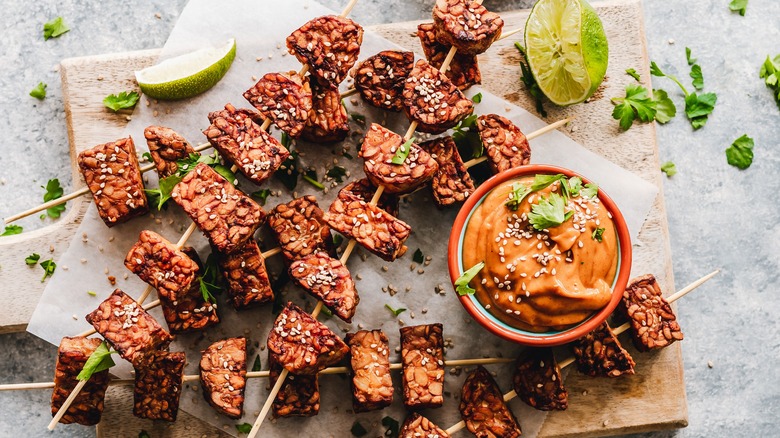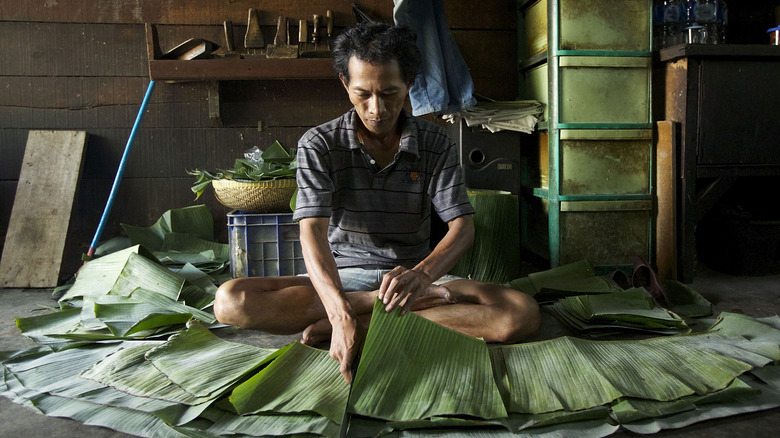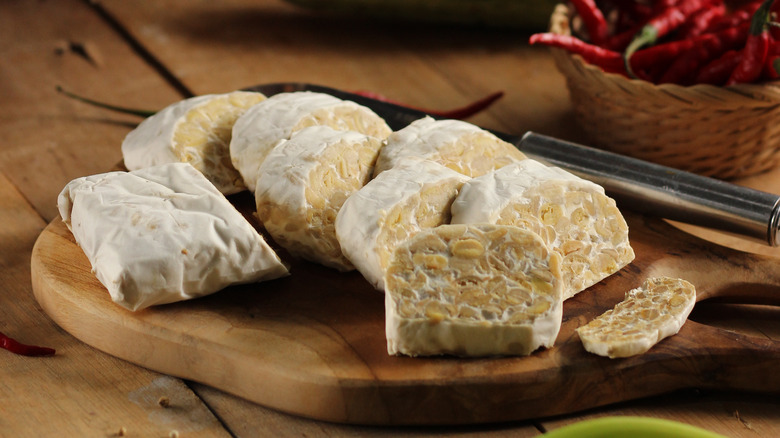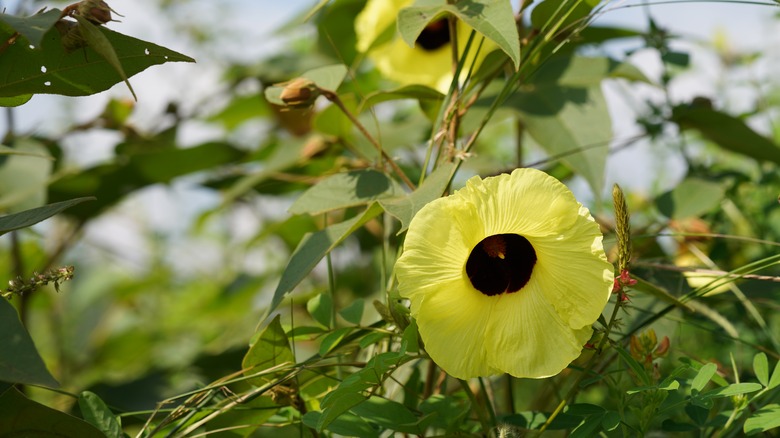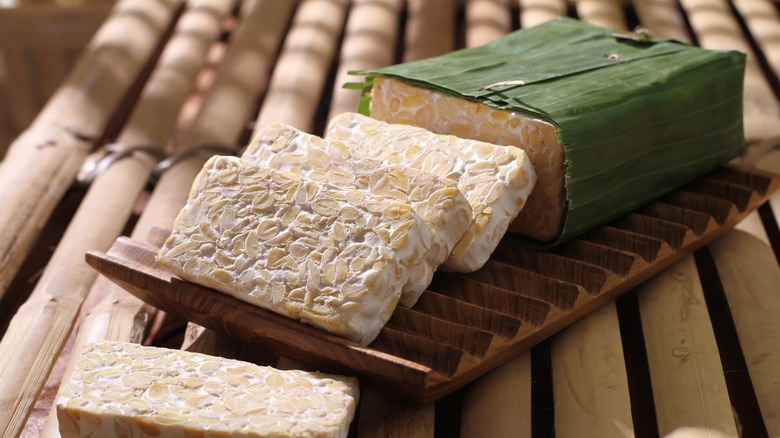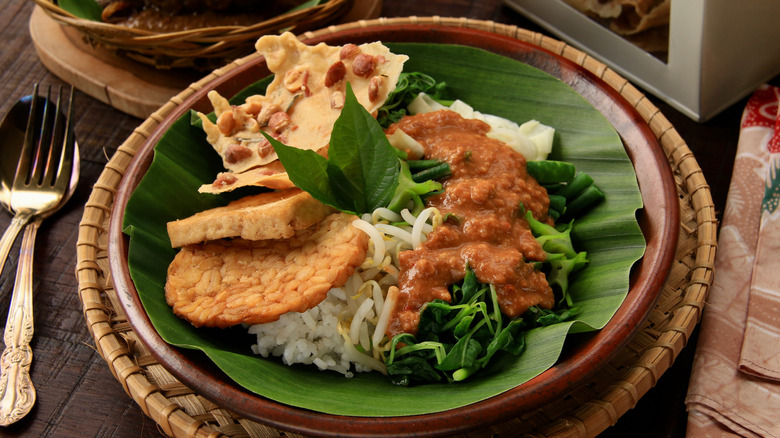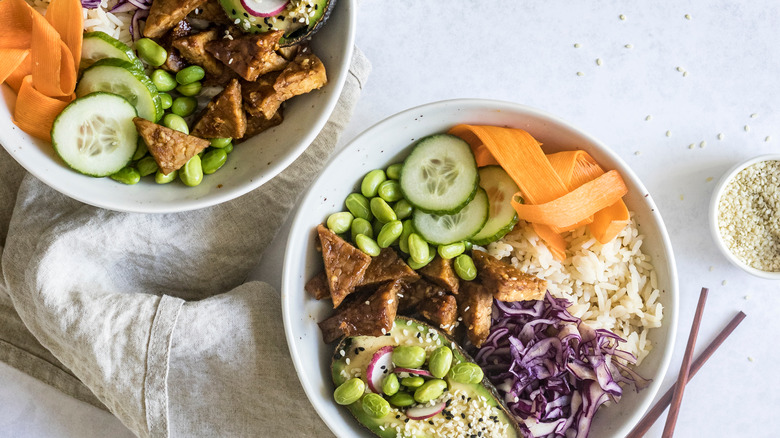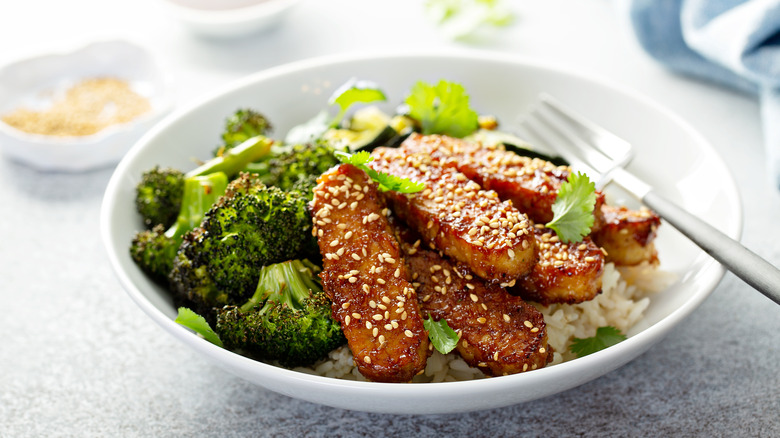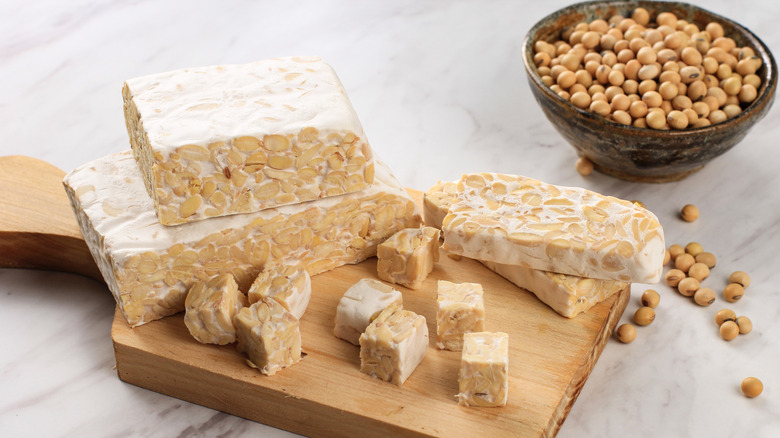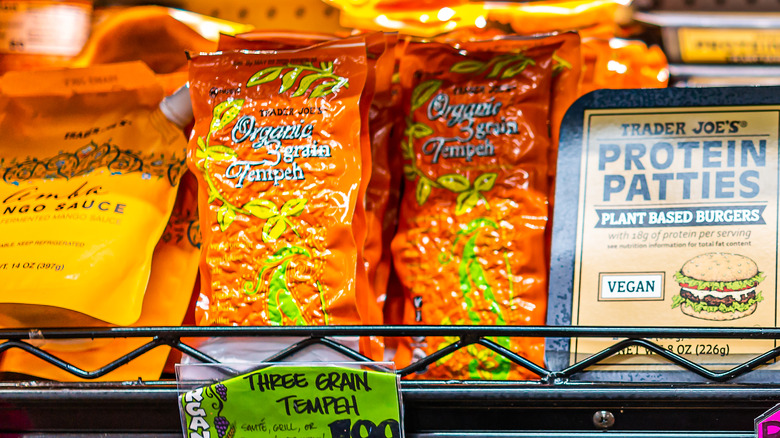13 Facts You Need To Know About Tempeh
One of the most exciting aspects of the culinary world is continually exploring the myriad of ingredients available across diverse world cuisines. Today, we've got an interesting one for you: Tempeh, an Indonesian staple made with fermented soybeans. Although Indonesia is the largest and most populous country in South Asia, its hearty cuisine remains relatively unknown to the rest of the world, perhaps due to the diversity of ingredients and preparations across its archipelago of 17,000 islands. Nonetheless, one food unites the Indonesian people — tempeh. Throughout its history in Indonesia, tempeh was considered an economical, protein-rich option for struggling families unable to afford meat. Over time, it developed into a symbol of Indonesian pride and identity. Meanwhile, in the west, tempeh was for far too long relegated to the sidelines as a plant-based food. Now, its nutty, earthy flavor profile and impressive nutritional credentials mean tempeh is fast becoming an essential weekly staple for culinary enthusiasts of all diets.
If you've always shied away from cooking the Indonesian specialty, this is your sign to try it. And if you're a certified tempeh lover, don't reach for that packet quite yet — first, join us on our journey as we answer all questions you've been afraid to ask, from its pronunciation (tem-pay), cultural significance, and mysterious history, to the traditional fermentation methods. Ready to do a deep dive? Let's get started.
The ancient food was created hundreds of years ago
Despite the illusion that vegan foods are a relatively modern innovation, two well-known examples, tofu and seitan, have well-documented historical roots in ancient China. Comparatively, tempeh is significantly more mysterious: Research shows that tempeh originated in the archipelago country of Indonesia — probably on the volcanic island of Java, which now hosts the country's capital city and economic centre — but what else do we know concerning the history of tempeh? It's widely agreed the earliest written mention of tempeh is in the "Serat Centhini," an epic compilation of poetry detailing tales of Javanese life in the 17th century, commissioned directly by the Crown Prince in 1814. Therefore, we can ascertain that, at the very least, the consumption of tempeh dates back 400 years; beyond this, historians are divided.
Some theorize that due to widespread distribution throughout all rural communities in Java, the sheer number of traditional Indonesian dishes utilizing tempeh, and the considerable variety of the superfood, that tempeh had an extensive history before the 17th century. The persuasive hypothesis suggests that trade with China brought soybeans to the island, and people soon developed tempeh. Unfortunately, even this cannot be conclusively dated, as although trade between the two countries commenced in 1000 AD, the earliest written reference to soybeans in Indonesia was in 1747. Although we cannot exhaustively date the Indonesian food, it remains evident that tempeh has a lengthy history across all areas of the island.
Fungus starts the fermentation process
We won't lie — making tempeh can be off-putting for uninitiated chefs. After processing soybeans (or other grains) and before initiating the fermentation, it's vital to ensure the environment is conducive to success: You need low oxygen levels, high temperatures, minimal ventilation, and mildly acidic pH levels between 3-5. Next, you need a starter, which acts as a catalyst. In modern tempeh production, this starter (known as tempeh culture or powdered tempeh starter — PTS) is typically a dried mixture of domesticated live Rhizopus oligosporus spores with rice or soybeans.
Rhizopus oligosporus is a domesticated variety of Rhizopus microsporus, a fungus (mold) pathogen that infects various plant matter. Unlike the latter, the rhizopus used in tempeh production doesn't produce toxins, making commercial tempeh completely safe to consume. Once the starter containing the spores is incorporated into the substrate, the mixture is spread out and allowed to ferment for 24-36 hours; over time, a mass of white mycelium binds the tempeh together and produces a nutty, earthy flavor. Although mold on food may sound unappealing, remember that many popular foods undergo fermentation, such as sourdough, yogurt, and cheese.
Traditionally, sea hibiscus is used to ferment tempeh
Tempeh production in small-scale cottage industry projects across Indonesia differs dramatically from the automation and mass production typical of large businesses. While factories use a standardized commercially sold dried tempeh culture, people making tempeh at home or as a small business likely use traditional, age-old methods. These techniques vary depending on geography and local tastes, but two stand out: The first uses the previous batch of tempeh as a starter, much as one would use a sample of yogurt to ferment a new batch. This method is accessible, but the danger of spoiling your tempeh with bacteria increases with each subsequent batch.
Traditional practice, on the other hand, utilizes a natural starter developed on sea hibiscus leaves (known as "waru" in Javanese). The Rhizopus oligosporus fungus naturally occurs on the underpart of sea hibiscus leaves and clings to the microscopic hairs known as trichomes. The soybean mixture is sandwiched between two leaves, left to ferment for a little over 24 hours, and — if successful — you'll be left with a beautiful cake of tempeh, bound together by the fluffy white mycelium. Depending on local availability, teak or banana leaves are also utilized to ferment the tempeh; it's hypothesized that ancient people may have wrapped cooked soybeans in the leaves to store them and accidentally created tempeh. Even though using a natural starter (named usar in Indonesian) produces mixed results and isn't scalable, it remains the prevailing approach to tempeh-making across the country.
Tempeh isn't always made with soybeans
When you think of tempeh, you likely envision the classic version made from white soybeans (tempeh kedele). However, did you know there are countless other ingredients traditionally used to make tempeh, from grains to pulses? Perhaps one of the earliest variations of tempeh was made with black soybeans, as the darker bean was introduced to Indonesia from China at the same time as its white counterpart. Another traditional component used in tempeh is coconut pulp (tempeh bongkrek), which according to a study in the Journal of Medical Toxicology, has a high chance of developing poisonous toxins — specifically, bongkrekic acid, an odorless, tasteless pathogen. Authorities have banned the production and sale of tempeh bongkrek due to the significant number of deaths associated with the product, but illegal production still occurs. Other popular additions to tempeh across Indonesia include soybean pulp from tofu production, peanuts, fava beans, cowpeas, mung beans, velvet beans, and jack beans.
Across tempeh-producing markets in Europe and North America, you'll often find various pulses and grains integrated into one tempeh cake. Popular mix-ins include black beans or grains such as millet, brown rice, and barley. These whole grains not only add extra nutrition but also contribute a delightful crunch and nutty flavor.
Customarily, tempeh is packaged in plant wrappers
As concerns regarding pollution, sustainability, climate change, and environmental policies increase, illuminating discourse about food packaging materials has slid into mainstream media. As per UNEP, "every minute, the equivalent of one garbage truck of plastic is dumped into our ocean," and within the packaging sector, more than two-thirds of the materials produced will ultimately serve as food wrappers (via Materials). Public outrage concerning excess plastic packaging has put pressure on grocery stores and conglomerates worldwide, forcing countries such as the U.S. and the U.K. to examine rural practices across Asia as a blueprint for sustainability.
Conversely, in Indonesia, it's common to see vendors selling tempeh on market stalls wrapped in biodegradable materials like banana leaves, teak leaves, bamboo, or recycled newspaper. Sometimes these are the same leaves used for traditional fermentation, while in other cases, it's simply a practical method to minimize waste. There are additional benefits, too — banana leaves, teak leaves, and bamboo each add a distinct aroma to the tempeh, making the food even more delicious.
It's usually gluten-free
Are you looking for a protein-packed, gluten-free alternative to meat? It's harder to find than you may expect. There's compelling evidence that celiac disease and gluten intolerance are becoming more common in the industrialized western world (via Beyond Celiac). Yet, many plant-based meat alternatives still rely on gluten. Seitan, one of the most popular alternatives, is made entirely from wheat gluten, and numerous other popular brands rely on wheat to replicate the chewy texture of meat. Luckily, tempeh is here to save the day: It's gluten-free and, as a bonus, has a distinctively chewy and firm texture, making it ideal for replacing meat or relishing alongside other proteins.
It's important to note there are numerous varieties of tempeh, each with its unique ingredients. While plain tempeh is typically gluten-free as it only compromises soybeans, tempeh culture, and occasionally vinegar, other sorts may not celiac-friendly. Some brands include additional whole grains, such as wheat and barley, which are not gluten-free. Moreover, flavored tempeh (smoked, barbecued, curried) can sometimes introduce gluten. As with most foods, we advise always consulting the label before purchasing — it's a worthwhile habit if you suffer from food allergies and intolerances or have dietary preferences.
It's used in traditional Indonesian dishes
Unsurprisingly, tempeh forms the basis of many delicacies spanning Indonesia's 17,000 islands. Perhaps the oldest dish containing tempeh is sambal tumpang, an aromatic curry made from galangal, lime leaves, fiery bird's eye chili, and creamy coconut milk, which was first documented in the 400-year-old "Serat Centini." Two regions claim the specialty of sambal tumpang: In Central Java, people eat it with boiled rice and steamed vegetables, while in Eastern Java, they enjoy it with a crispy salad topped with spiced peanut sauce. Both territories agree on the main ingredient — tempeh semangit, an over-fermented tempeh with a strong odor that lends itself to the heavily spiced and fragrant dish.
Now, countless years later, Indonesian people have learned to capitalize on the tempeh's versatility, using the protein-packed ingredient in many ways, from frying to boiling and steaming to roasting. A sought-after recipe enjoyed in homes and street-food markets alike is tempeh goreng, where deep-fried tempeh slices are coated with a sweet, spicy, and sticky sauce. We highly recommend seeking it out, even if it means queuing to get a taste.
Tempeh is a protein powerhouse
We've all heard that question: "Where do vegans get their protein?" Whether you've been the one asking the question or the one on the receiving end, the answer is simple: There are countless vegan protein sources, from nuts, lentils, beans, and vegetables. Uniquely, tempeh is a complete source of protein — meaning it contains all the amino acids our body needs to function, unlike other foods such as nuts and lentils. Moreover, how much protein is actually in tempeh might surprise you — one cup of the plant-based superfood contains a whopping 31g of protein, equivalent to the same serving of beef. That's significantly more than other soy-based foods like tofu.
Tempeh isn't exclusively about protein, either. Due to the high quantities of nutty whole grains and beans in the nutritious food, it's exceptionally high in fiber — a carbohydrate that keeps us full for prolonged periods and aids in regulating our blood sugars. Furthermore, the fermentation process needed to make tempeh makes it easier for our bodies to digest the protein-rich soybeans and develop probiotics, beneficial bacteria vital for gut and digestive health. So, will you be including more tempeh in your diet?
Say hello to one of the best meat substitutes
Burgers, bacon, mince, sausage — tempeh can do it all. For hungry vegetarians and vegans looking to replicate the taste of meat without the ethical implications, there's no need to pine after foods that seem like a distant memory. Don't let other plant-based meat substitutes like tofu put you off; while many abandon tofu because of its texture or taste, tempeh is a different case. It has a chewy, firm, and meaty texture capable of soaking up the intense flavors of sauces, combined with an in-built robust nutty, earthy, mushroomy flavor packed with umami.
Because tempeh is an immensely versatile ingredient, distinct cooking techniques produce different results. Crumble or grate tempeh and season with smoky, fiery spices to make succulent taco fillings, sausage bits to top pizza, or mince for Italian bolognese. On the other hand, slabs of crispy marinated tempeh can be transformed by serving with either a hearty stew, aromatic curry, fresh side salad, noodles, or rice. Maybe you're craving an English breakfast or pancakes with bacon? Cut sliver-thin slices of tempeh, and marinate with tamari, maple syrup, some spices, and liquid smoke — the key to an authentic vegan bacon flavor. If you haven't tried tempeh yet, what are you waiting for? It could be your next favorite meat substitute.
Black spots on tempeh are perfectly normal
Imagine this: You've bought some tempeh, and it's been sitting in your fridge for a few days. You pull out the packet, excited to make a delicious meal — but the tempeh looks a little strange. You take a closer look. Instead of the creamy-white exterior that you expect, there are large black spots covering the entirety of the tempeh. If you're anything like us, alarm bells will ring, and you might consider throwing the tempeh in the garbage just to be safe. Although this scenario will be familiar to anyone who has handled tempeh and is understandably concerning, the black spots are harmless; they won't affect taste, smell, or nutrition. While it can be unpleasant to imagine, the black patches are merely spores of Rhizopus oligosporus, the fungus used to initiate fermentation, reaching maturity. Some describe this effect as similar to the marbled appearance of blue cheese: natural and harmless.
Be that as it may, tempeh is not impervious to unwelcome mold growth. If your tempeh takes on a slimy, wet, mushy, or crumbly texture, you should throw it away. Another telltale sign of tempeh past its date is its smell; although tempeh naturally has a vague ammonia scent, the overwhelming aroma should be noticeably earthy and nutty, comparable to mushrooms. Conversely, if you notice a powerful whiff of odor akin to ammonia or alcohol, your tempeh is no longer safe to eat. Ultimately, always err on the side of caution.
Fresh and pasteurized tempeh taste different
You may be familiar with the conception of pasteurization as it relates to dairy products like milk, but did you know that tempeh undergoes the same procedure? In an article published in Food Processing Technology, pasteurization is described as "a mild heat treatment in which food is heated to below 100 degrees Celsius" to stop the fermentation process from resuming, which results in quicker spoilage. After pasteurization, most foods have an extended shelf-life — which is beneficial to businesses, as it's easier to ship globally — and to the consumer since it's safer. Subsequently, producers always pasteurize the commercialized tempeh you'll find at the grocery store.
That said, some small-batch gourmet tempeh producers oppose pasteurization, claiming that it impacts the freshness and negatively affects the flavor. Many Indonesian cottage industries follow the same ethos; indeed, over-fermented tempeh (or tempe semangit, as it's known locally) is a delicacy. However, it's important to remember that un-pasteurized tempeh requires careful sanitation, cannot be eaten raw, and must be consumed within a few days of purchase.
It's been growing in popularity
Jackfruit, seitan, and tofu have been prevalent ingredients in the kitchens of home cooks across South America and Asia for millennia. North America and Europe, though, present a different story; just a few decades ago, these ingredients seemed obscure and strange. Now, people in various countries are rightfully coming to appreciate, respect, and enjoy these foods — particularly as plant-based meat substitutes. Tempeh is no different. Formerly, it was common to see people from a privileged, western-centric stance labeling the food "weird" or "gross" due to the healthy fermentation process. While some people are still reticent to try tempeh, the food has grown in favor and developed a strong fanbase since its introduction to America in the 1960s.
As proof that attitudes around tempeh are changing, a recent report by The Business Research Company revealed that North America constitutes the largest market for this Indonesian product. Despite disruption from the COVID-19 pandemic, the global market grew from "$4.93 billion in 2022 to $5.3 billion in 2023, at a compound annual growth rate (CAGR) of 7.6%." The report notes the correlation between the growing number of vegetarians and vegans worldwide and the market for tempeh, citing it as one of the major driving factors. By 2027, it's predicted that sales of tempeh products will tally over $7.3 billion — and as the demand for tempeh gains further traction, you can expect to find more goods on grocery shelves or restaurant menus.
You can buy tempeh at grocery stores
Not everyone wants to make tempeh from scratch — and we get it! Dealing with cultures and fermentation requires extensive research and is undoubtedly an advanced and time-consuming process. The next best thing would be to sample fresh tempeh sold in the street markets of Indonesia's bustling cities, where vendors sit with gigantic slabs of tempeh packaged in banana leaves, waiting to slice them for you. However, if you're like us and can't rationalize a trip to Indonesia just for tempeh, you'll likely find this plant-based staple in your local specialty or health food store. In metropolitan cities across the U.S., major grocery stores cum health food shops such as Whole Foods Market, Trader Joe's, and Sprouts Farmers Market often stock soybean tempeh, grain tempeh, and flavored tempeh.
You may also be surprised to discover that many branches of large chains like Target, Walmart, and Winco stock tempeh at an affordable price — for example, although it's not guaranteed to be at your local store, Lightlife (a significant tempeh producer) is stocked in over 3500 Walmart stores. Likewise, U.K. supermarkets Tesco, Waitrose, and Sainsbury's provide well-known brands Plant Power and The Tofoo Co to tempeh-loving consumers. Search for it in the same refrigerated section as plant-based favorites like tofu, burgers, and vegan deli meats.
